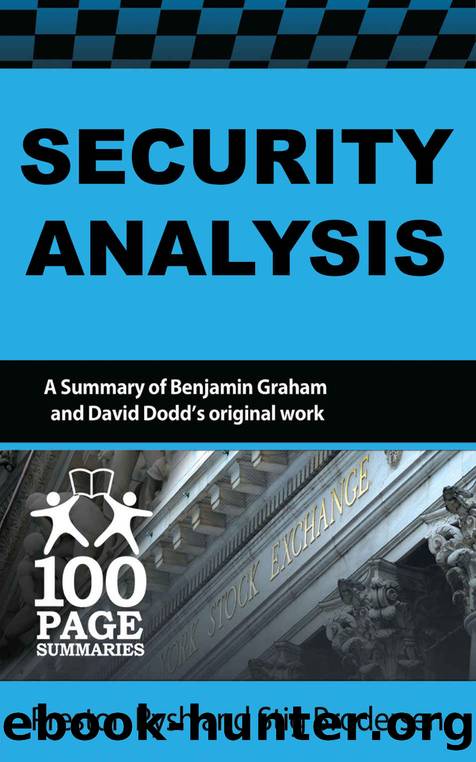Security Analysis (100 Page Summaries) by Preston Pysh & Stig Brodersen

Author:Preston Pysh & Stig Brodersen
Language: eng
Format: mobi, epub
Publisher: 100 Page Summaries
Published: 2014-09-29T18:30:00+00:00
Chapter 29âSummary
The Dividend Factor in Common Stock Analysis
In this chapter, the reader learns some important opinions on the methods for valuing Common Stocks. First, Graham expresses his opinion that common stocks should be valued in a similar manner as bonds. Instead of valuing a coupon, Graham suggests the investor should value the dividend. Grahamâs main concern with common stocks is the companyâs method for distributing the earnings to the shareholders. Graham is of the strong opinion that a substantial portion of the companyâs earnings should be distributed directly as a dividend to the shareholder. For example, if a company has consistent earnings of $7 a share, $5 should be paid to the shareholder as a dividend. Graham thinks the higher dividend payment is more important than a lower and more consistent payment. His main reason for suggesting such a high dividend payment is because he thinks most companiesâ managements donât use the retained earnings to add more value to the shareholders. Instead the money is used as reserves for acquisitions (which proportionally add little value) or excessive salaries. Although Graham feels some companies can add value while retaining large portions of earnings, these businesses or far and few between.
Chapter 29âOutline
In a simple, yet important proclamation, Graham says the quantitative value of a common stock is based on three factors:
1. Dividend rate and record
2. Earning power (From the Income Statement)
3. Asset value (From the Balance Sheet)
Dividend Return as a Factor in Common-stock Investment: Although many modern investors look at common stocks differently than bonds, Graham suggests that the market price of common stocks will perform similarly if management pays a healthy and sustainable dividend. To demonstrate his conclusion, he shows two different companies over a decadeâs period that paid a consistent $7 and $6 dividend. During this time, the earnings of the companies fluctuated consistently (anywhere from $19.00 per share to $5 per share). Despite the constant change in earnings, the dividend remained intact, and so did the market price. Grahamâs point was confirmed by showing that the market price of the common stock reflected the actions of a bond with a similar coupon yield.
Established Principle of Withholding Dividends: If the management decides to withhold a portion of the earnings (the amount not being paid as a dividend), the theoretical reason is management is using the capital to benefit the shareholder. Graham claims that two companies with the same general business model and the same earnings will trade at different prices if the dividend policy is different. The market will value the company with the higher dividend more favorably.
Policy of withholding dividends questionable: Graham raises a very important question: Should a company pay a lower dividend in order to create stability for the owner with an assured payment, or should they pay a higher dividend and meet its obligation irregularly? For example, if a companyâs earnings fluctuate between $5 and $15 dollars a year, the average would be $10. Therefore, the ideal situation would be receiving an $8 dividend, while management retains $2 in surplus.
Download
Security Analysis (100 Page Summaries) by Preston Pysh & Stig Brodersen.epub
This site does not store any files on its server. We only index and link to content provided by other sites. Please contact the content providers to delete copyright contents if any and email us, we'll remove relevant links or contents immediately.
Zero to IPO: Over $1 Trillion of Actionable Advice from the World's Most Successful Entrepreneurs by Frederic Kerrest(4069)
Machine Learning at Scale with H2O by Gregory Keys | David Whiting(3651)
Harry Potter and the Goblet Of Fire by J.K. Rowling(3612)
Never by Ken Follett(3540)
Ogilvy on Advertising by David Ogilvy(3345)
Shadow of Night by Deborah Harkness(3179)
The Man Who Died Twice by Richard Osman(2815)
Book of Life by Deborah Harkness(2723)
My Brilliant Friend by Elena Ferrante(2705)
How Proust Can Change Your Life by Alain De Botton(2617)
0041152001443424520 .pdf by Unknown(2603)
Will by Will Smith(2586)
The Tipping Point by Malcolm Gladwell(2563)
How to Pay Zero Taxes, 2018 by Jeff A. Schnepper(2503)
Purple Hibiscus by Chimamanda Ngozi Adichie(2498)
Hooked: A Dark, Contemporary Romance (Never After Series) by Emily McIntire(2426)
Rationality by Steven Pinker(2153)
Borders by unknow(2119)
Daughter of Smoke and Bone by Laini Taylor(2084)
